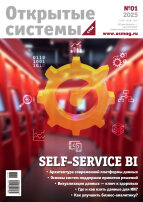.jpg) COVER FEATURES
COVER FEATURES
IN FOCCUS: MACHINE LEARNING
Practical Aspects of Machine Learning
Currently, lots of hopes are being put onto machine learning, but the success of the technology will be determined not only by an adequate algorithm selection, but also by taking the right steps at the planning, development, and implementation stages.
Victor Kitov (vkitov@mail.ru), mathematician, MSU Faculty of Mathematics and Cybernetics; assistant professor, Plekhanov Russian University of Economics.
Machine Learning for Natural Language Understanding
Natural language processing technology has made great progress thanks in no small part to machine learning, which is used for text understanding among other things.
Pavel Velikhov (pavel.velikhov@gmail.com), director of science, Toprater.com (Moscow).
Machine Learning for Query Planning
The growing data volumes increasingly require advances in database query performance. An optimization of a query execution plan using machine learning techniques yields many-fold response time improvements.
Oleg Ivanov (o.ivanov@postgrespro.ru), Postgres Professional, MSU Faculty of Mathematics and Cybernetics.
Machine Learning for a Big Data
Theoretical foundations of machine learning have emerged almost simultaneously with the first computers. Still, when using machine learning techniques in practice, the specific system architecture must always be accounted for. Processing big data with Hadoop requires tools for adapting machine learning algorithms to the platform, which can be done, for example, using elements of the IBM BigInsigths stack.
Andrey Orlov (Andrey.Orlov@ru.ibm.com), Big Data solutions expert, IBM Russia and CIS.
Assessing Student Competencies Through Social Network Analysis
The third generation of Russia’s National Higher Education Standards define learning tasks in terms of students’ competencies, which necessitates an evaluation framework. This is where machine learning technology comes to help enabling to assess students’ competencies by analyzing their behavior in social networks.
Mikhail Zakharov (inststud@mail.ru), deputy dean; Anatoly Karpenko (apkarpenko@mail.ru), head of department; Elena Smirnova, deputy head of department, Bauman MSTU.
PLATFORMS
The TOP500 List and Progress in High Performance Computing
For more than two decades, the TOP500 list has enjoyed incredible success as a metric for supercomputing performance and as a source of data for identifying technological trends. The project’s editors reflect on its usefulness and limitations for guiding large-scale scientific computing into the exascale era.
Erich Strohmaier (estrohmaier@lbl.gov), senior scientist, Lawrence Berkeley National Laboratory; Hans W. Meuer, professor emeritus, University of Mannheim; Jack Dongarra (dongarra@eecs.utk.edu), University of Tennessee; Horst D. Simon (hdsimon@lbl.gov), deputy director, Lawrence Berkeley National Laboratory.
INTERNET OF THINGS
Reference Architectures for the Internet of Things
The Internet of Things (IoT) is about innovative functionality and better productivity by seamlessly connecting devices. But a major threat is the lack of architecture standards for the industrial Internet and connectivity in the IoT. The article gives a review of recent IoT architecture evolution and what it means for industry projects.
Michael Weyrich (michael.weyrich@ias.uni-stuttgart.de), director, University of Stuttgart’s Institute for Automation and Software Systems; Christof Ebert (christof.ebert@vector.com), managing director, Vector Consulting Services.
Internet of Things for enthusiasts: weather station with visualization
Internet of Things develops today thanks not only to companies offering solutions specifically designed for the Internet of things, but also enthusiasts who extremely need new tools to work with interactive with each other «smart» things.
Edward Lebediuk (lebeduk93@gmail.com), Consulting Engineer, InterSystems corporation, graduate student Plekhanov Russian University of Economics (Moscow).
DBMS
DBMS Cost-Based Optimizers: Back Story and State of the Art
Query optimizers for relational databases have come a long evolutionary way to grow into complicated algorithms for assessing the costs of various options. However, the new generation databases pay almost zero attention to a query cost. What is it, a step back or two steps ahead? Do we even need new cost optimizers for the big data world at all?
Leonid Borchuk (le.borchuk@gmail.com), database administrator, Yandex.
EXPERIENCE
Private Cloud for the Masses
Using OpenStack, one can build a private cloud today. However, the experience of implementing real-world projects has shown that SMB companies prefer turnkey standardized scalable hardware and software solutions packaged with tech support services.
Vladimir Sigunov (vsigunov@tmoperatorgroup.ru), technology director, TM Operator Group (Moscow).
THE WORLD
DISPAK: Operating System for USSR Nuclear Project
Nuclear research had been playing a defining role in the political and social and economic development of USSR in the post-WWII era. In particular, Soviet nuclear project has become a powerful driving force for the development of computers, applied math, and software programming. One of the most prominent software products created thanks to the nuclear project was the DISPAK operating system designed for the Soviet-era BECM-6 computer.
Irina Kraineva (cora@iis.nsk.su), researcher, A.P. Ershov Institute of Informatics Systems (Novosibirsk).
IT UNIVERSITIES
On the Way to Open Science
New information systems for scientific collaboration help to tighten scientists’ responsibility for the quality of works they publish, which enables a wider and more open use of the results. One example of such information systems is Socionet.
Sergey Parinov (sparinov@gmail.com), deputy director, Central Economics and Mathematics Institute (Moscow).
LIBRARY
IT at a Turning Point
The November, December, January, and February issues of Computer magazine (IEEE Computer Society, V. 48, No. 11, 1, 2015, and V. 49, No. 1, 2, 2016) cover the topics of exascale systems, technology outlook near the end of the Moore’s law, fusion of humans and cyber systems, and new cloud computing trends.
Alexander Tyrenko (shoorah@osp.ru), reviewer, Computerworld Russia.
